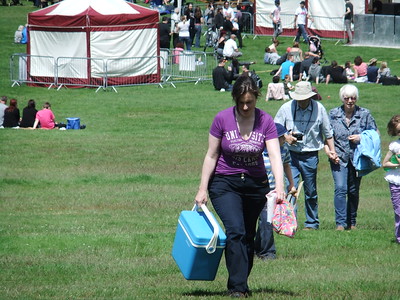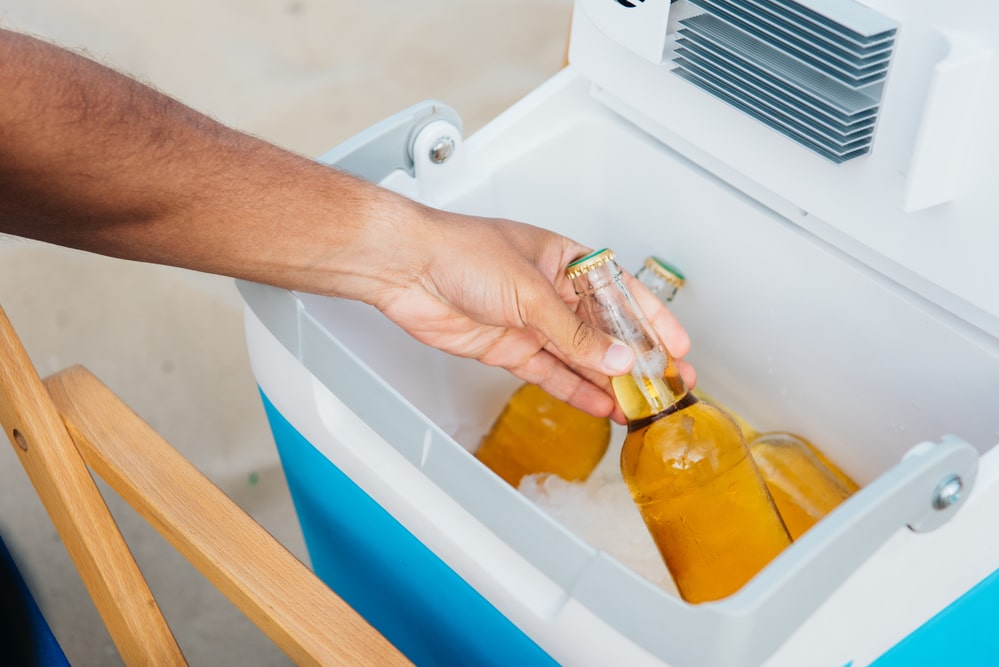Cool boxes are ideal for keeping your food and drinks cool when you’re camping or even just out in the garden on those summer days.
A cool box is a fantastic addition to any outdoor activity. Whether you are going camping, fishing, or even on a boat trip, the benefits of having one with you are enormous. However, if you have never used one before, using it can seem quite a challenge, which can be pretty frustrating.
If you follow the tips below, you will learn how to use a cool box in no time at all and enjoy the many benefits they provide.
How to Use a Cool Box the Right Way: Tips and Tricks
Latest camping addition – electric cool box #glamping pic.twitter.com/1tR8K7mk
— President Business (@Noeljones75) May 25, 2012
Pre-Chill the Food & Drinks
Using cold packs or an ice cooler bag with water-filled gel packs can help keep all the food chilled. Make sure everything is already cooled off before putting it in your bin. A hot piece of chicken, for example, will raise the temperature of all your other food much sooner, leading to spoilage.
Properly Pack
The best way to ensure food stays chilled when packed in an ice chest is to fill it with as much ice as possible. Use large, flat ice blocks at the bottom of the cooler, so they don’t shift around. Then, place your foods on top and finish the topping with another block of ice.
Freeze Bottled Water
Try frozen bottles of water if you have no ice and need something that keeps food cold for longer. The bottles will take hours to thaw, but they’ll keep everything else cold while they do so. You can even refreeze them once they’ve thawed out if you need more ice water.
Put the Ice in Last
The easiest way to keep your food and drinks cold is with ice packs, but you can’t just stick them anywhere. Use an insulated cooler that is deeper than it is wide.
Fill up all of that space with ice packs or frozen water bottles. When it comes time for packing, place your frozen foods on top of that layer of ice, then fill in the extra space with the remaining ice packs.
Don’t Drain Water
A cooler box works by evaporative cooling, meaning your food gets chilly because it’s exposed to cold air. But if you drain the cold water in your cool box’s water reservoir, you dry out its air-cooling mechanisms. When that happens, even more water needs to go into your cooler to keep working.
Pack All the Essentials on Top
Cool boxes are great for carrying your food, but it’s not always practical to add everything on top. Pack like items together in tightly sealed plastic bags, and then place those bags into containers.
Layers of like items help prevent different foods from rubbing against each other and creating condensation.
Keep the Lid Closed
When you’re transporting your food, it’s essential to close your cool box immediately after loading it. Keeping all vents closed when not in use will help prevent warm air from seeping into your cool box and allow you to keep food cold for longer.
Top Tips When Using a Passive Cool Box
Yeah I have an electric cool box in my boot! Im gonna put the ice cream men out business! pic.twitter.com/S3jqRj7x
— Charlie Winzar (@charliewinzar) July 26, 2012
Keep It Latched and Closed
A cold cooler is excellent for keeping food and drinks cold during picnics or days at the beach, but always it latched and closed.
This will ensure that your items remain as cold as possible for as long as possible. Remember: If it’s not latched, close it.
Keep Food Organised and Separated
Don’t forget your custom cut-to-fit foam sheets if you carry more than one cooler. This is important because it will keep the food separated and organised in your cooler. Otherwise, you may end up with melted frozen foods and room temperature products.
Pack Beer in a Separate Cooler
If you are bringing beer to a picnic or any event where you don’t have access to ice, plan and pack it in a different ice box cooler.
Place it in your main cooler with plenty of ice when you aren’t serving it. You can purchase special boxes that insulate beer or buy insulated lunch bags at any grocery store.
Clean and Air-Dry Your Cooler After the Trip
After returning from your camping trip, clean and air-dry your cooler and rinse it out with soap and water before drying it off. It’s also important that you store your cooler in a dry place.
If your cooler is wet or dirty, bacteria can grow and cause food poisoning like any food product. Store it in an area that is well ventilated, and avoid stacking heavy items on top of it.
Types of Ice Used in a Passive Cool Boxes
Dry Ice
While dry ice sounds like some futuristic material, it’s just frozen carbon dioxide (CO2). Carbon dioxide is a colourless, odourless gas.
When put into liquid form, it can be used as an instant coolant for foodstuffs and is usually stored under pressure as a liquid (known as Carbon Dioxide Liquid or CDL).
Ice Cubes
You need ice cubes to get your frozen goods from one place to another. The easiest way to freeze your food and drinks is in plastic freezer bags or using suitable containers with ice cubes. Ice cubes are typically used in a cold cooler without any water. That said, it’s worth mentioning that well-frozen ice cubes can last up to two days.
Block Ice
Ice can be beneficial if you have a freezer or fridge where your food isn’t kept at ideal temperatures. Use block ice to keep perishable items cold and avoid any potential for cross-contamination from defrosting frozen foods (which can then grow bacteria).
What to Consider When Buying a Cool Box
Capacity
Cool boxes come in various sizes, and most of them are bigger than a regular backpack. If you intend to travel long distances, buy a big cool box that can carry enough water, food, and drinks for your trip.
Portability

No matter what kind of event you’re transporting food for, you’ll want to ensure that your cool box is easy to carry around. Lightweight and cool compact boxes are often easier to transport than larger ones.
It can also be handy if they come with wheels or trolley-style handles, so they don’t have to be carried in your hands when on the go. This is particularly important if you need a cool box for outdoor events where there will be a lot of walking or if there are stairs involved at any point.
Design and Shape
There are many different designs of cool boxes. Some have square or rectangular shapes, while others may be oval or cylindrical. So if you’re going to need one that you can feed foodstuffs such as hot dogs, sandwiches and freezing water, always go for a spacious model that is somehow partitioned to help you organise your whole cooler during short and longer trips.
Type of Insulation
Insulation that freezes isn’t a very effective insulator. If you live in a freezing climate, you’ll want to consider insulation. The insulation of your cool box plays a crucial role in keeping the ambient outside temperature out of your cooler, even if the cooler is opened regularly. The proper insulation ensures the food can stay cold without freezing it.
Passive vs Thermoelectric Cool Boxes
The majority of cool boxes sold at retail stores today are thermoelectric. For example, these cool thermoelectric boxes will run in two ways.
The motor is turned on by the internal temperature sensor to power the fan. The fan is driven by battery-operated Peltier elements that need active cooling and external power. You can get ones with integrated solar panels (what you may see referred to as hybrid cool boxes).
Passive cool boxes tend not to be manufactured anymore. Passive cool boxes consist of a styrofoam shell with evaporation from an ice pack used for cooling. The key difference between passive and thermoelectric coolers is that passive coolers require no electricity.
Can I Use Cool Bags?
Yes, cool bags are only ideal for keeping food cool for approximately 12 hours – if packed with a proper amount of ice packs. Not only are they lightweight, but also inexpensive. Moreover, they are less bulky compared to both passive and powered coolers. Cool bags are also ideal for picnics.
Keep Your Food Fresh on Your Journey
Cool boxes can be a lifesaver if you travel with perishables, but they have drawbacks. Consider how you will use your cool box, and make sure it suits your needs before you buy one!
Additional Resources
- How to Sharpen Scissors With a Knife Sharpener
- How to Make Ground Coffee Without a Coffee Maker
- Where to Place a Stove Fan
- How Does an Ice Maker Work
- How to Make Courgette Noodles Without a Spiralizer
Tom is a former chef turned full-time food blogger. He has always been passionate about food, and loves nothing more than experimenting in the kitchen and sharing his recipes with others. Tom’s blog is one of the most popular food blogs on the internet, and he has won numerous awards for his cooking. When he’s not blogging or cooking, Tom enjoys spending time with his wife and two young children.

